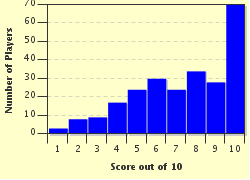Quiz Answer Key and Fun Facts
1. On June 18, 1940, a French general gave a speech over BBC Radio from London, appealing to his people to continue the fight against Nazi Germany. His words, "Whatever happens, the flame of the French resistance must not be extinguished and will not be extinguished" inspired an underground movement that was instrumental in defeating the Nazis. Who was the French military officer?
2. This African-American dancer left her native country to live and work in France, and became a participant in the Resistance. Her duties included smuggling coded messages out of the country. She was so popular with the French people that the Germans hesitated to bother her. Who was this remarkable American?
3. This young woman was born in France of French-English parents. She became an SOE (Special Operations Executive) agent for England after her husband was killed at El Alamein. Her contributions to the French Resistance were so great that a book was written about her called "Carve Her Name with Pride", which was later made into a film. Her name was Violette Szabo. What was her fate?
4. This Irish writer and dramatist was a resident of Paris at the onset of the Occupation. He was an active member of the French Resistance, placing himself in danger many times. He would go on to win the Nobel Prize for Literature. One of his great works is "Waiting for Godot". Who was he?
5. This man is still remembered as a symbol of the Resistance. As a high-ranking Resistance member he was ordered to consolidate the many underground groups operating in France during the Occupation. He was made head of the Conseil National de la Résistance, which coordinated all underground activities. He died after being arrested and tortured by the Gestapo. Who was this French national hero?
6. He was an author, a politician, and a Resistance fighter. Captured twice by the Gestapo during the Occupation, he escaped or was rescued both times. He was a hero, highly decorated after the war. Who was this man, author of "Man's Hope" and "Man's Fate"?
7. This French writer and poet was born in Paris in 1895. A member of the Communist Party, he took part in the Resistance as a courier and writer of Underground publications. His poetry, written during the war, was widely read and admired by the French during the Occupation. His Russian-born wife, named Gala, would leave him for the artist Salvador Dali. Who was he?
8. This man was another Nobel Prize-winning author. One of his most famous works, called "The Plague", is an allegory about the spread of Nazism. He was editor of the Underground newspaper "Combat", and worked for the Resistance during the war. Name this Algerian-born French author.
9. Among the most heroic Resistance members were the "ordinary people" who stepped up to fight for France's freedom. One such woman was Berthe Fraser. She saved the lives of dozens of British pilots stranded behind enemy lines, organizing an "underground railroad" to smuggle them to safety. This was just one of her many contributions. Yet Berthe Fraser was betrayed twice, and was arrested and tortured by the Nazis twice. Did she survive the war?
10. Who were the Maquis?
Source: Author
robbieh
This quiz was reviewed by FunTrivia editor
bloomsby before going online.
Any errors found in FunTrivia content are routinely corrected through our feedback system.

